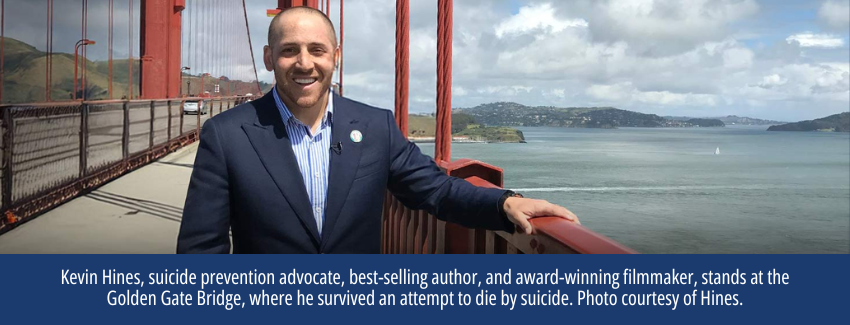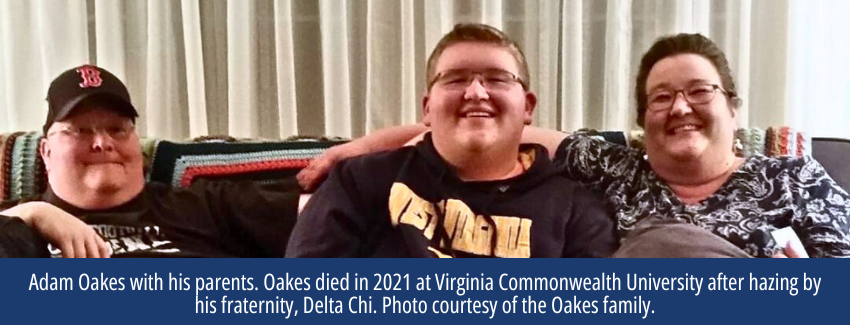Hazing, mental health, and the weight of silence
Public speaker and suicide survivor Kevin Hines teams up with HazingInfo to explore the intersection of hazing and mental health
_____________________
By Kevin Hines and Sierra Medina
The toll of hazing varies and can include lasting negative impacts from physical injuries, alcohol poisoning, and tragic loss of life.
and tragic loss of life.
But the scars that hazing leaves aren’t only physical. They can also be emotional, psychological, and deeply damaging.
During Mental Health Awareness Month, we need to explore a painful truth: Hazing is trauma. Left unaddressed, that trauma can amplify existing mental health struggles, cause new emotional distress, and silence those who suffer.
Hazing is not an innocent tradition, it’s trauma. It can cause feelings of humiliation or embarrassment, and it can leave deep scars, emotional, psychological, and sometimes even physical that last long after the moment is over.
The combination of peer pressure, humiliation, power dynamics, and isolation creates fertile ground for anxiety, depression, PTSD, and, in some cases, suicidal thinking.
Since 2000, at least seven deaths by suicide have been identified in which hazing was cited as a contributing factor, according to HazingInfo’s database of hazing deaths. The experience of being hazed, and/or being expected to haze others often conflicts with people's personal values, which can contribute to something known as a moral injury.
Beyond the visible harm, hazing erodes trust, fractures relationships, and traps students in secrecy, often leading people to feel isolated and alone. And, when people feel like hazing is inevitable or believe others think it's acceptable behavior they are less likely to reach out for help. Research shows that 95% of students who experience hazing do not report it.
These numbers remind us: The true toll of hazing is far greater than what the data captures. Because hazing so often goes unreported or is misclassified, the true prevalence of hazing-related mental health impacts remains unknown.
Recognizing these unseen harms is essential to understanding the comprehensive effects of hazing and to advancing prevention, intervention, and support strategies.
Why “consent” doesn’t apply to hazing
One of the most dangerous myths around hazing is the idea that victims are willing participants, which makes some people believe these harmful behaviors are okay. But real consent under the conditions of hazing is impossible. A strong desire to belong, coupled with coercion, fear, group loyalty, and emotional pressure distort true choice. That’s why hazing overlaps so clearly with other forms of power-based violence like bullying, harassment, or sexual violence.
When someone says “yes” to a hazing practice, whether explicitly or implicitly, they may not feel they can say “no.” And when that psychological weight meets existing mental health struggles, the results can be particularly devastating.
From silence to support: what must change
The call to action is clear, hopeful, and urgent: We have to interrupt the cycle and stop pretending hazing and bullying are rites of passage. We need new leaders to replace hazing “traditions” with welcoming, relevant, and supportive new member processes, healing, compassion, and support.
To live out that change, here's what is needed:
- Awareness and education: Training that connects hazing with mental health outcomes, so communities understand the physical and psychological harms.
- Transparent reporting and accountability: HazingInfo’s work to make hazing incident data public will give us a clearer picture of the intersection of hazing and mental health. When tragedies are visible, they become harder to ignore.
- Support systems and safe paths: Students must have access to confidential, trusted resources; medical and mental health services; support to lead groups, teams, and organizations with respect for others, and easy reporting mechanisms.
- Cultural shift: Prevention means rejecting the idea that “this is how it’s always been done.” Healthy group norms prioritize belonging without harm.
If you or someone you know is struggling from hazing, bullying, harassment, or anything else, you are not alone and you deserve support.
In the US, dial 988 for the Suicide & Crisis Lifeline. Outside the US, find your local crisis hotline. Additional resources are available at StopHazing.org or HazingInfo.org.
Pain is real. Hope is real. And every student deserves a path toward healing, support, and safety.

Kevin Hines is an mental health and suicide prevention activist, best-selling author, and award-winning filmmaker. After surviving a suicide attempt from the Golden Gate Bridge in 2000, he has spent more than 15 years sharing his story of hope, resilience, and recovery, advocating for mental wellness, suicide prevention initiatives, and policy change. Learn more about Kevin and his resources at Kevinhinesstory.com.




